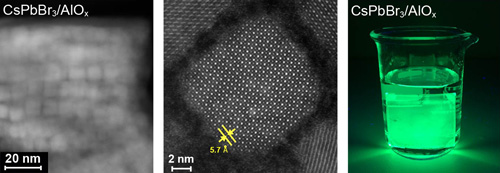| Posted: May 29, 2017 |
New method improves stability of perovskite quantum dots
(Nanowerk News) EPFL scientists have built a new type of inorganic nanocomposite that makes perovskite quantum dot exceptionally stable against air exposure, sunlight, heat, and water.
|
|
Quantum dots are nanometer-size, semiconducting materials whose tiny size gives them unique optical properties. Much effort has been put in building quantum dots from perovskites, which already show much promise for solar panels, LEDs and laser technologies. Their fundamental optoelectronic properties are also very unique and of great interest among the scientific community. However, perovskite quantum dots have huge issues with stability against air, heat, light, and water.
|
|
EPFL scientists have now succeeded in building perovskite quantum dot films with a technique that helps them overcome these weaknesses. The work is published in Angewandte Chemie ("CsPbBr3 QD/AlOx inorganic nanocomposites with exceptional stability in water, light and heat").
|
 |
| Electron microscopy images of perovskite quantum dots embedded in the protective alumina matrix, and a photograph of the same film stable in water. (Image: R. Buonsanti/EPFL) (click on image to enlarge)
|
|
The new approach to stabilize the perovskite quantum dots was developed in the lab of Raffaella Buonsanti at EPFL Valais Wallis. The innovation of this study, developed by Anna Loiudice and PhD student Seryio Saris, lies in a technique called “atomic layer deposition” (ALD), which is commonly used to fabricate ultra-thin films with high uniformity in their structure.
|
|
The idea was to use ALD to encapsulate the perovskite quantum dots with an amorphous alumina matrix, which acts as a gas and ion diffusion barrier thus making the quantum dots more robust against air, light, heat, and moisture.
|
|
The team used an array of characterization techniques to monitor the nucleation and growth process of the alumina matrix on the quantum dot surface. The process showed that the interaction between the ALD precursor and the dot surface is crucial in order to uniformly coat the dots while preserving their optoelectronic properties.
|
|
“By addressing the stability challenge of perovskite quantum dots, this work is expected to greatly impact the field by enabling fundamental optoelectronic studies, which require the samples to be stable during the measurements, in addition to increase the durability of devices based on this new class of quantum dots,” say the authors.
|

